The Zumbrunnen family descends from the Barons of Attinghausen. As already discussed, the first Zumbrunnen in history was Walter Zumbrunnen, who had been born into the Attinghausen family and changed his name to Zumbrunnen in the year 1209.
But who were the ancient Attinghausens? There are some undisputed facts, and then two basic theories about their origin. It’s unlikely the answer can ever be fully known, with just too much lost in the mists (and fires) of time.

The seal of Werner Von Attinghausen dated to a letter from October 19, 1264. Clockwise from bottom are the letters “DE — TTINGENHVSEN” (the full seal said Wernheri De Attingenhvsen).
The Attinghausens were the only members of the upper nobility in the Canton of Uri where they occupied the Attinghausen Castle. Much of the land in Uri was owned by the great church the Fraumünster of Zürich, but the Barons of Attinghausen held this land as fiefs. They also owned much land outright.
Beginning in the mid-1200s, the family is very well-documented. One example is the seal at right, attached to a letter that Werner Von Attinghausen sent in October 19, 1264. (There were several generations of men in the family named Werner, so it’s not always clear which is which.)
By the mid-1200s, and possibly earlier, the Von Attinghausen family was also known as Von Schweinsberg and controlled several castles near Bern that are now completely ruined. (Their landholdings in Bern were specifically in a valley called Emmental, which is now famous for its cheese.) The name Von Schweinsberg seems to have originated in Bavaria, Germany.
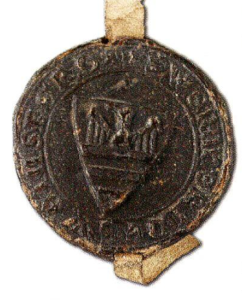
A seal of Werner Von Attinghausen from November 19, 1303. Clockwise from the top it says “S. WERNHERI DE SWEINSBERG”
When they conducted business in the Emmental Valley near Bern they used the name Von Schweinsberg. When they conducted business in Uri, they used the name Von Attinghausen. At right, is a seal of Werner’s from 1303 using the “Von Schweinsberg” name.
Around the late 1200s, the estates were divided, likely as part of an inheritance between two brothers, Werner and Diethelm. Werner remained in Uri and began to exclusively use the name Von Attinghausen. Diethelm resided near Bern and began to exclusively use the name Von Schweinsberg.
The Von Attinghausen branch of the family became pivotal figures in the creation of an independent Switzerland. The male line of both branches died off over the next century or so.
Of the above facts, there is no dispute. The question is: where did this family come from originally and how did they acquire two baronies that were so far apart from each other?
Theory 1: Colonizing Nobles
Aside from the Holy Roman Emperor himself, the most powerful noble family in Switzerland in the 1100s and 1200s were the Dukes of Zähringen, who controlled lands in Bavaria and across Switzerland, including near the city of Bern (a city the Dukes of Zähringen founded).
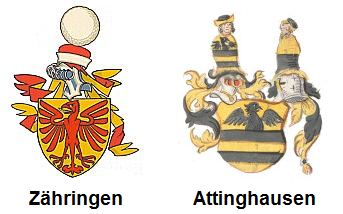
The coats of arms of the Zähringen and Attinghausen family have some similarities: an eagle with his wings extended and tongue out, although this was a common motif in the Holy Roman Empire.
Thus one hypothesis is that the original Barons of Attinghausen were loyal knights of the Zähringen who were given the newly created barony of Attinghausen, possibly as an award for valorous military service (often the basis for awarding new baronies) and also because they could be trusted to act on the behalf of their sponsors.
One family in particular has been identified: a family named Von Signau who lived near Bern. Several facts support this theory:
- The family traces back to a Werner Von Signau who is mentioned in records in 1130 and 1146. Though merely circumstantial, Werner is also a common name among the Barons of Attinghausen.
- The Von Signau family certainly served the Dukes, and held lands and a castle or two in the Emmental Valley, near Bern and in the heart of the Zähringen sphere of influence. A particularly cool piece of evidence for this is a treasure chest (in the collection of the Swiss National Museum in Zürich) which was given to Werner Von Attinghausen as a wedding gift and has the seals of many other noble families from Bern, indicating his close social ties to the region.
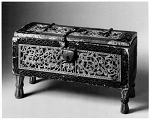
A small treasure chest, given to Werner Von Attinghausen as a wedding present, is held by the Swiss National Museum
- The lands that the Von Schweinsberg family controlled in the Emmental Valley were an enclave within Von Signau lands. One possible way that such an arrangement could have arisen is through land being divided via inheritance.
Thus if this theory is correct, a descendant of Werner Von Signau distinguished himself with valorous service to the Dukes of Zähringen and was awarded the Barony of Attinghausen in addition to his lands near Bern, perhaps around 1173. As the deputy of the dukes he was thus an outsider who came to Uri, set himself up in the mighty castle, and retained his power even after Berthold V, the last Duke of Zähringen, died in 1218.
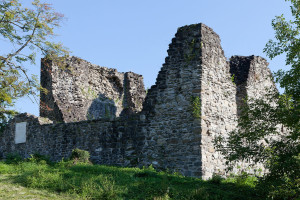
The ruins of the Castle of Attinghausen
The other theory is that the Barons of Attinghausen were a family with deep and ancient local ties. Uri was very remote in the Middle Ages, primarily accessible via Lake Lucerne, and not easily reached via land. The mountain pass from Uri to Italy, known as the Gotthard Pass, was accessible only via a treacherous footpath. The first bridge was not constructed until 1220, so it was not yet an important trade route.
In antiquity, Uri was under the rule of the Roman Empire, part of the Roman province of Maxima Sequanorum. But as the Roman Empire collapsed, the tribe of the Alemanni swept in. The archaeological record suggests this was the last major colonization of the valley.
Thus the second theory is that the Barons of Attinghausen were the leading local family who were elevated to barons, perhaps because this was far easier than sending someone in to attempt to displace them. (The historian Theodor Von Liebenau speculates the family could have been awarded a barony in their homeland for serving Emperor Frederick I in his campaigns against Italy.)

Another version of the Attinghausen coat of arms.
- The most recent archaeological excavations of Attinghausen Castle show it was built atop an even older castle that originated in the 1000s or 1100s. This early construction date suggests an occupant of the castle well before the Dukes of Zähringen. It would have taken serious effort to dislodge the occupant from such a powerful and remote fortress. The original church appears to also have been built in this much earlier era.
- The ancient church books mention members of the Attinghausen family who are completely unknown in the 1200s and 1300s and thus likely represent earlier generations from the 1100s. These include Lamprecht, Albrecht and Heinrich, and women named Bertha and Othilia. Lamprecht is thought to be the builder of the castle.
- Very early on, perhaps as early as 1206 but certainly by the late 1200s, the Attinghausen men were not just barons with authority from Rome, but held the title of landammann, implying popular support of the people of the valley. This situation is nearly unprecedented and may make more sense if the Barons of Attinghausen were viewed as kinsman of the valley people rather than outside colonizers.
- Also early on, the Barons of Attinghausen appear to have fought and negotiated for the independence and democratic rights of the people of Uri, an unusual stance (to put it mildly) for barons of this era.
Thus if this theory is correct, a leader of the men in Uri built a powerful castle in a remote alpine valley, and through service to the emperor (or as the only expedient way to control Uri) was elevated to baron. His family then married an heiress to the Von Signau and acquired lands near Bern as well. But the Barons remained more loyal to their kinsman than to other nobles, and helped establish the independence of central Switzerland.
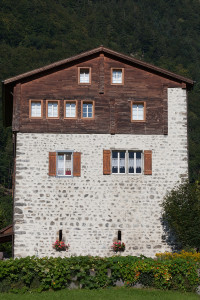
The Schweinsberg Castle in Uri was clearly a junior castle to the mighty Attinghausen Castle
Old historians like Von Liebenau and Girard believed the Barons of Attinghausen were an ancient family from Uri. For much of the 20th century, many historians favored the hypothesis that they were colonizing members of the Von Signau family. But the most recent excavations, suggesting such an early construction date for the castle, also favors the theory that the Attinghausen’s were an ancient family from Uri.
It is likely that this fascinating debate can never be decisively resolved.
Edit: In initially conducting this research, I thought the evidence was somewhat stronger that the Barons of Attinghausen were an ancient family from Uri who married a Von Signau heiress. I said it was likely that this fascinating debate can never be decisively resolved.
But after writing this post, Ulysse Ulrich Schnegg Zumbrunnen, who lives in Switzerland and has researched the family in great detail, writes that the “Colonizing Nobles theory” is the correct one. He says that while an earlier family indeed inhabited the castle, they likely died off, and the Von Signau came in and took their name. I have included his comment here so that people do not miss it!
To the people of Uri it is clear that the von Attinghausen / von Schweinsberg family arrived from the Emmental.
The Burg Schweinsberg was built by Werner III von Signau, henceforth called Werner von Schweinsberg (1212).
That plot of land had been under control of the Barons von Signau.
The von Signau family was closely linked to the Counts von Kyburg, von Habsburg and the Dukes von Teck and Zähringen.
The inhabitants of the original Burg Attinghausen don‘t seem to be linked to this family directly. They are unknown and must have become extinct.
…
I would therefore date the family not to 1209 but to 1130 (first mention of Frh. Werner I von Signau).
Note: I have used the date 1209 on this blog because it appears to be when the name Zumbrunnen first came into use. I certainly agree with Ulysse that “the family” came into existence before this date.
Sources

[…] witness the name of Attinghausen in the centuries in which it was first adopted.(There’s a debate over the origins of this family. Girard believes they’re an ancient family from Uri; the alternate theory is […]
[…] would have grown up. The castle was built perhaps as early as the 1000s or 1100s, although it is uncertain who the first owners of the castle were. It was expanded in the 1200s and was certainly the home of our relatives Werner Von Attinghausen […]
[…] of the Barons of Attinghausen, the only one of the higher nobility who lived in Uri. (There are two theories about the origins of the Barons of Attinghausen; this is some of the evidence that they are an […]
[…] The genealogy of the Barons of Attinghausen and Schweinsberg has never been documented in great detail because this once prominent family died off so long ago. Many of the records this far back are fairly muddled. While parts of this tree are very clearly established, other pieces are in dispute. At some point, I’ll create links to the individual members of this tree that will discuss which links are secure and which are more speculative or uncertain. For more about the origins of this interesting family, read here. […]
Desr Josh
To the people of Uri it is clear that the von Attinghausen / von Schweinsberg family arrived from the Emmental.
The Burg Schweinsberg was built by Werner III von Signau, henceforth called Werner von Schweinsberg (1212).
That plot of land had been under control of the Barons von Signau.
The von Signau family was closely linked to the Counts von Kyburg, von Habsburg and the Dukes von Teck and Zähringen.
The inhabitants of the original Burg Attinghausen don‘t seem to be linked to this family directly. They are unknown and must have become extinct.
You are welcome to join our family‘s Facebook Group Zumbrunnen von Attinghausen von Signau, if you wish.
I would therefore date the family not to 1209 but to 1130 (first mention of Frh. Werner I von Signau).
Best wishes
Ulysse Ulrich Schnegg Zumbrunnen
Thanks Ulysse — I am going to amend my post to conclude with your important comment!